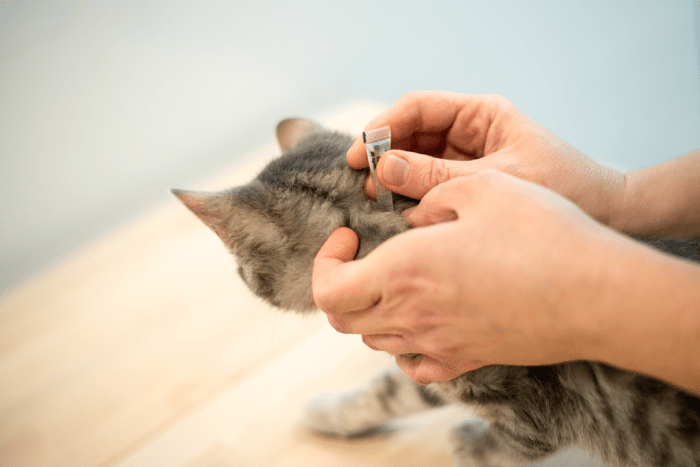
Pets and Pests — How to Keep your Furry Friends Safe
September 26, 2022
By Daniel Baldwin, BCE, CCFS, CP-FS
When it comes to pests, most pet parents have two main concerns — keeping unwelcome critters out of their homes and safeguarding their furry friends from the relentless attack of common pests. If you are one of the 70% of U.S. households that owns a pet, let’s look at how to keep your home and all its residents safe and healthy.
Why you should shield your pets from bugs
Even if our pets are an unstoppable bundle of energy, they are still susceptible to sickness and disease. Parasites and pests are an insidious and nearly invisible threat to our beloved animals. From nasty insect bites to life-threatening parasite infestations, do you know what to look out for?
Protect your family
Your pets are not the only ones at risk — these pesky little critters can also be troublesome for your family. Companion animals can easily bring pests into the home, and these unwelcome guests can transfer to furniture and humans. While an ant infestation might cause temporary havoc in the kitchen, other pests will come with worse consequences. From bedbugs to lice and fleas, your family and belongings can be severely affected without effective pest control for your pets.
What are the worst pests for your pets?
Some pests are just an inconvenience for your pet, while others can cause serious health issues and even death. Here are the most common bugs to look out for.
Fleas
If your dog or cat has ever had fleas, you will know how distressing it can be. Fleas feed on your pet’s blood and can cause various health problems, ranging from mild to life-threatening. These tiny parasites can cause excessive scratching, dermatitis, anemia, and allergic reactions; they are also carriers of tapeworm larvae. Tapeworms are intestinal parasites that can affect your pet’s digestive system and cause severe health concerns if left untreated.
Because fleas reproduce quickly, with one flea laying almost 20 eggs a day, infestations rapidly spread. While these pesky critters can’t survive on humans, they can jump from our pets to us and leave itchy, inflamed bites. The risk of severe health problems from a fleabite is minor but not impossible, and the itchiness is something we can all do without.
Ticks
Like fleas, ticks are parasites that attach themselves to a host to feed off its blood. Ticks don’t discriminate between humans and animals; they easily bite into any warm-blooded body. Bushland, wooded areas, and tall grass are prime zones for ticks.
Ticks can be hard to see once they make their way through your pet’s fur. If undetected, anemia and skin irritations are the best-case scenarios. Lyme disease, Rocky Mountain spotted fever, and other potentially lethal infections are the worst possible outcome.
Mosquitoes
Mosquitos are as much of a bother and danger to us as to our pets. Their itchy, annoying bites can be maddening, but the diseases mosquitos carry are the real threat. Dogs and cats risk being infected with heartworm, Saint Louis encephalitis (SLE), West Nile virus (WNV), and other parasites. Controlling your mosquito problem with effective pest control is the key to having your family and companion animals enjoy being outdoors.
Rodents
Unlike the other pests we’ve discussed, rodents will try to avoid your pets. However, their presence can be enough to harm your beloved fur babies. Mice and rat droppings can spread dangerous viruses such as parvo and rabies. If left untreated, parvo has a 90% mortality rate. Rabies is ever more dangerous — once it develops, it cannot be cured and ends in death. If a rabid animal bites us, we can also contract the viral disease. Moreover, rodents carry parasites and bacteria such as roundworms, leptospirosis, and toxoplasmosis, which are just as dangerous. On top of that, these scurry creatures are one of the primary carriers of fleas.
Mites
Mites are skin parasites that live in animals’ fur or ears. Most domestic pets can be affected, including dogs, cats, rabbits, hedgehogs, and other small mammals. Because they feed on the skin’s keratin, mites cause redness, itchiness, hair loss, slabs, and lesions. Most mites will easily spread from animal to animal and also attach themselves to humans. Scabies is the best-known human condition caused by an infestation of these itchy skin parasites.
Lice
You might be scarred by childhood experiences of itchy heads and forced haircuts, but the good news is that lice cannot be passed to you from your pets. Lice are species-specific, meaning they can only survive on carriers of the same species. In other words, dog lice can only transfer to other dogs, cat lice to cats, human lice to humans, and so on. What’s more, cat and dog lice are much rarer than human lice and are typically only found on sickly, malnourished, or young animals.
Bed bugs
A bed bug infestation is everybody’s worst nightmare. These tiny pests spread quickly and easily. Bedding, clothing, and furniture can all become infested. While bed bugs don’t like fur, they will do what they must to survive. From hitching a ride on our pets to giving them a nibble when better alternatives (like our blood) aren’t available, bed bugs are critters of convenience. Their bites cause redness and itching but don’t usually have serious health consequences for pets or humans.
Ants
Ants are a big nuisance for our furry friends; they can crawl all over them, bite them and get into their food. Fire ants are the most dangerous species, with their venomous bite resulting in pain and swelling. Your pets are not the only family member at risk. Fire ant bites are painful and nasty for humans too. In severe cases, fire ants can cause an anaphylactic response in animals or humans. The best way to avoid these irksome crawlers is with effective pest control to keep them out of your house and yard.
Spiders
According to The Washington Post, spiders could theoretically eat every human on Earth in one year. Luckily for us, neither we nor our pets are their meal of choice — at least not in the United States. Getting bitten is another story, though. With over 3,500 species of spiders living alongside us, your pet will likely get bitten at least once in its lifetime.
In the U.S., the only two spider species that pose a real threat to your pets are widow spiders and recluse spiders. If these species are present in your area, speak with your vet about the symptoms to look out for and how to act if your pet is bitten.
How can you protect your pets (and yourself) from pests?
Start by regularly administering topical treatment against the most common parasites. Flea, tick, and heartworm medications are standard practices for responsible pet owners. Additionally, groom your dog, cat, or another beloved fur baby. This great bonding activity allows you to check for anything out of the ordinary.
When cleaning your home, wash and change your pet’s bedding to avoid it becoming a filthy nest for pests. If your dog or cat is allowed outside, a well-maintained yard is less likely to be home to bugs and parasites.
Get professional help when needed
If you are suffering from a pest problem, or your companion animals are constantly dealing with parasites, it’s time to turn to the experts for help! From pet groomers to house cleaners and residential pest control technicians, a wealth of trained professionals are ready to banish those pests and help protect you, your fur babies, and your home.
Categories
RELATED POSTS






